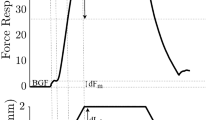Summary
In order to better understand the organization of the locomotor control system, we examined the temporal patterns of distal hindlimb muscle responses to brief electrical stimulation of cutaneous nerves during walking on a treadmill. Electromyographic recordings were made from twelve muscles; stimuli were applied individually to three nerves at random times throughout the step cycle. A new graphical technique was developed to assist detailed examination of the time course and gating of complex reflex patterns. The short latency reflexes were of two primary types: inhibition of extensors and excitation of flexors; these responses were only evident during locomotor phases in which the respective motoneuron pools were active. Longer-latency response components were gated in a similar but not identical manner, suggesting some independence from the basic locomotory influence on the motoneuronal pool. The phase-dependent gating of reflexes appeared to be consistent with a functional role for reflex responses during locomotion. The reflex responses of muscles with complex anatomical actions were often correspondingly complex.
Similar content being viewed by others
References
Abraham LD, Loeb GE, Marks WB (1981) Comparison of normal use and reflex response patterns of cat distal hindlimb muscles. Soc Neurosci Abst 7: 688
Abraham LD, Loeb GE (1985) The distal hindlimb musculature of the cat: patterns of normal use. Exp Brain Res 58: 580–593
Andersson O, Forssberg H, Grillner S, Lindquist M (1978) Phasic gain control of the transmission in cutaneous reflex pathways to motoneurones during “fictive” locomotion. Brain Res 149: 503–507
Andersson O, Grillner S (1981) Peripheral control of the cat's step cycle. I. Phase dependent effects of ramp-movements of the hip during “fictive locomotion”. Acta Physiol Scand 113: 89–101
Andersson O, Grillner S (1983) Peripheral control of the cat's step cycle. II. Entrainment of the control pattern generators for locomotion by sinusoidal hip movements during “fictive locomotion”. Acta Physiol Scand 118: 229–239
Bak MJ, Loeb GE (1979) A pulsed integrator for EMG analysis. Electroenceph Clin Neurophysiol 47: 738–741
Duenas SH, Loeb GE, Marks WB (1984) A quantitative comparison of hindlimb muscle activity and flexor reflexes in normal and decerebrate cats during walking. Soc Neurosci Abst 10: 628
Duysens J, Loeb GE (1980) Modulation of ipsi- and contralateral reflex responses in unrestrained walking cats. J Neurophysiol 44: 1024–1037
Duysens J, Loeb GE, Weston BJ (1980) Crossed flexor reflex responses and their reversal in freely walking cats. Brain Res 197: 538–542
Engberg I, Lundberg A (1969) An electromyographic analysis of muscular activity in the hindlimb of the cat during unrestrained locomotion. Acta Physiol Scand 75: 614–630
English AW, Letbetter WD (1982) A histochemical analysis of identified compartments of cat lateral gastrocnemius muscle. Anat Rec 204: 123–130
Forssberg H (1979a) On integrative motor functions in the cat's spinal cord. Acta Physiol Scand Suppl 474
Forssberg H (1979b) Stumbling corrective reaction: a phasedependent compensatory reaction during locomotion. J Neurophysiol 42: 936–953
Forssberg H (1981) Phasic gating of cutaneous reflexes during locomotion. In: Taylor A, Prochazka A (eds) Muscle receptors and movement. MacMillan, London, pp 403–411
Forssberg H, Grillner S, Halbertsma J (1980) The locomotion of the low spinal cat. I. Coordination within a hindlimb. Acta Physiol Scand 108: 269–281
Forssberg H, Grillner S, Rossignol S (1975) Phase dependent reflex reversal during walking in chronic spinal cats. Brain Res 85: 103–107
Forssberg H, Grillner S, Rossignol S, Wallen P (1976) Phasic control of reflexes during locomotion in vertebrates. In Herman RM et al. (eds) Neural control of locomotion. Plenum, New York, pp 647–674
Grillner S, Zangger P (1979) On the central generation of locomotion in the low spinal cat. Exp Brain Res 34: 241–261
Hagbarth K-E (1952) Excitatory and inhibitory skin areas for flexor and extensor motoneurons. Acta Physiol Scand 26: Suppl 94: 1–58
Kanda K, Burke RE, Walmsley B (1977) Differential control of fast and slow twitch motor units in the decerebrate cat. Exp Brain Res 29: 57–74
Loeb GE (1982) Task groups — a proposed functional unit for motor control. Soc Neurosci Abst 8: 947
Loeb GE (1984) The control and responses of mammalian muscle spindles during normally executed motor tasks. Exp Sport Sci Rev 12: 157–204
Loeb GE, Marks WB, Hoffer JA (1983) Reflex recruitment of individual cat hindlimb motoneurons by cutaneous shocks during normal walking. In Reflex organization of the spinal cord and its descending control. IUPS Satellite, Canberra, Australia, Abst 1.9
O'Donovan MJ, Pinter MJ, Dum RP, Burke RE (1982) The actions of FDL and FHL muscles in intact cats: Functional dissociation between anatomical synergists. J Neurophysiol 47: 1126–1143
Phillipson M (1905) L'Autonomie et la centralisation dans le systeme nerveux des animaus. Trav Lab Physiol Inst Solvay, Bruxelles 7: 1–208
Rasmussen SA, Goslow GE, Hannon PR (1982) Locomotion of partially deafferented cats. Am Col Sports Med Abstr.
Schomburg ED, Behrends H-B (1978) Phasic control of the transmission in the excitatory and inhibitory reflex pathways from cutaneous afferents to α-motoneurones during fictive locomotion in cats. Neurosci Lett 8: 277–282
Schomburg ED, Behrends H-B, Steffens H (1981) Changes in segmental and propriospinal reflex pathways during spinal locomotion. In Taylor A, Prochazka A (eds) Muscle receptors and movement. MacMillan, London, pp 413–426
Sherrington CS (1910) Flexion-reflex of the limb, crossed extension reflex, and reflex stepping and standing. J Physiol (Lond) 40: 28–121
Sherrington CS, Sowton SCM (1915) Observations on reflex responses to single break-shocks. J Physiol (Lond) 49: 331–348
Stuart DG (1981) A critique of the papers by Rossignol, Julien, Gauthier and Lund; Forssberg; Schomburg, Behrends and Steffens; and Andersson and Grillner. In: Taylor A, Prochazka A (eds) Muscle receptors and movement. MacMillan, London, pp 437–446
Wand P, Prochazka A, Sontag K-H (1980) Neuromuscular responses to gait perturbations in freely moving cats. Exp Brain Res 38: 109–114
Author information
Authors and Affiliations
Rights and permissions
About this article
Cite this article
Abraham, L.D., Marks, W.B. & Loeb, G.E. The distal hindlimb musculature of the cat. Exp Brain Res 58, 594–603 (1985). https://doi.org/10.1007/BF00235875
Received:
Accepted:
Issue Date:
DOI: https://doi.org/10.1007/BF00235875




